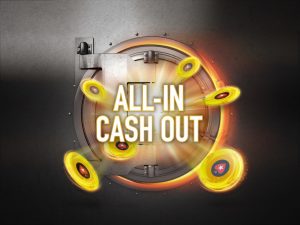PokerStars Launches All-in Cashout Feature on Real-money Sites
Poker is very much a game of logic and math, but for whatever reason, most poker players believe in some sort of completely unreasonable theory or see patterns where patterns do not exist. An early one for me was that A-2 suited was an amazing hand because you have an ace and you can make a flush and you can make a straight! My current stupid belief is that when I get it all in with the best of it, I am definitely going to lose. And I am definitely, definitely going to lose if I have aces against kings. The third king is totally going to rear its ugly head. Fortunately for us pessimists, PokerStars announced the launch of the All-in Cash Out feature yesterday, enabling us to wiggle our way out of all-in situations with our sanity intact.
In theory, All-in Cash Out, which was tested for a couple of weeks on the PokerStars.net play-money client, is simple, but in practice, it can get a bit confusing, so let’s start unpacking everything.
I want my money and I want it now
 The All-in Cash Out feature will present itself when a player is all-in, there is a call, and there is no further action pending. All that is left to come are the rest of the community cards. At that point, play is paused so the involved players can decide if they want to cash out or continue play.
The All-in Cash Out feature will present itself when a player is all-in, there is a call, and there is no further action pending. All that is left to come are the rest of the community cards. At that point, play is paused so the involved players can decide if they want to cash out or continue play.
If they both choose to continue (and we will just go with the hand being heads-up at this point because it is easier), the hand plays out as normal. No problem.
If either player opts to cash out, they receive a percentage of the pot proportional to their probability of winning the hand. This probability is displayed on the table. So, if Player A is 80 percent to win and the pot is $10, PokerStars will pay him $8. PokerStars also takes a 1 percent fee from the player’s payout, so Player A would actually receive $7.92.
Note that I said that “PokerStars will pay” the players who choose to cash out. This is important. The money does not come from the pot. The big reason for this is if only one player cashes out, that means the other player chose to resume, so he is still eligible to win the pot. In our above scenario, if Player B decided to resume and won the hand, he would scoop the entire pot as he would have done without the All-in Cash Out feature. After all, it wouldn’t be fair if he only got 20 percent when he didn’t hit the cash out button.
PokerStars has a stake in the hand
As you might be able to tell, this means that PokerStars can actually lose or win money in a hand aside from the rake and the 1 percent fee. If one player cashes out and that player wins the hand, PokerStars gets the pot, as the losing player can’t get it and the cash-out player is no longer eligible to win it. Using our example, the cash-out player received $7.92 from PokerStars (I am ignoring the regular rake) and PokerStars took the $10 pot. PokerStars profited $2.08.
If it is the reverse situation and the cash-out player loses, the other player gets the pot. In this case, PokerStars still paid the cash-out player $7.92, but Stars doesn’t get anything else, so PokerStars actually loses money.
If both players cash out, PokerStars pays them and takes the pot, profiting because of the 1 percent fee.
In an All-in Cash Out scenario, players are effectively playing against the house, something we are not used to in poker.
PokerStars is very aware of this last point and addressed the matter in a blog post:
Would PokerStars manipulate the cards in order to get the result that is most beneficial to us?
Absolutely not.
In no way whatsoever will PokerStars manipulate the dealing of any cards. The only way that PokerStars will make any direct revenue from this feature is through the 1% surcharge. While PokerStars will take the pot in hands where a player has Cashed Out but then goes on to win the hand, overall the number of pots won and lost will balance out according to Expected Value (EV).
Therefore, PokerStars will only break even in this regard, and subsequently the only revenue we will receive will come from the 1% surcharge.
“PokerStars has developed a reputation over almost 20 years. There is absolutely no way we would risk this by attempting to influence any results,” the world’s largest online poker room added. “The potential downside is far greater than any potential upside. It simply does not make business sense, and when coupled with the fact that PokerStars is highly regulated, be assured that the dealing of cards will remain as random as it has always been.”
All-in Cash Out at lowest stakes, limit game types
The All-in Cash Out feature is only available at micro-stakes cash tables, consisting of $0.01/$0.02, $0.02/$0.05, and $0.05/$0.10 stakes. It is also limited to No-Limit Hold’em, Pot-Limit Omaha, and 6+ Hold’em games. While it is in play at all of these tables – there are not specially-marked tables for All-in Cash Out – players can change their settings to not even have it come up as an option. Of course, other players may still use it, so strategies could need to be adjusted accordingly.
Additionally, though many in the poker community were afraid that this meant the demise of the Run It Twice option, PokerStars has said that Run It Twice is, in fact, still available.

















COMMENTS